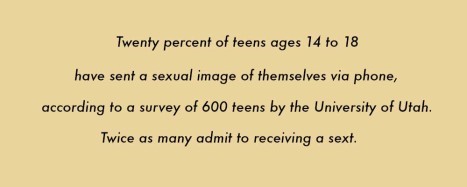After seeing the number of kids going through the justice system, attorney Karen Steinhauser, started her free educational talk, “It’s not the 70s anymore.” The talk covers legal issues that affect young adults, particularly sexting.
Steinhauser offers to give the talk at middle and high schools throughout Denver. A local northeast Denver middle school replied to her offer, “Oh, these kids don’t do anything like that—they’re good kids. They don’t even know what sexting is.” She gets this reaction a lot.
Steinhuser suggested she give the talk anyway.
“How many of you have received nude or inappropriate photos on your phone?” Steinhauser asked the class of sixth-graders. Three-quarters of the room raised their hand. Administration was shocked.
“How many of you know that you can be charged as a sex offender for having these types of photos on your phone?” Confused looks spread and hands lowered.
Twenty percent of teens ages 14 to 18 have sent a sexual image of themselves via phone, according to a survey of 600 teens by the University of Utah. Twice as many admit to receiving a sext.

Steinhauser has visited more than 10 schools in Denver and found sexting is happening to some degree at all of them. At one school, she found students treated sexting as casually as trading baseball cards.
“It’s not about whether they’re good kids. They’re all good kids, but they’re kids. Adults have to talk about this stuff with them.”
While not every young adult is sexting, almost all are hearing about it. Most are unaware of the legal consequences, though.
Currently, anyone who possesses a nude or inappropriate photo of a minor can be charged as a sex offender. The law, originally written in 1998, was intended to protect children from sexual predators. There are no restrictions on age, and consent does not have to be proven. This means anyone who receives a nude photo, however far along the chain of sharing, can be charged. “They [kids] don’t get it. They honestly don’t get it. The legal side is not really talked about with them,” she says.
She feels badly for the millennial generation. In the 70s, young adults caught drinking or having pot would get a stern warning from their parents or maybe a ticket. Now, when young adults make mistakes online there are potential lifelong implications.
This year, Colorado proposed downgrading the charge from a felony to a juvenile misdemeanor, but the bill was shot down in the House. The revision was intended to hold teens accountable, but eliminate the lifelong consequences of being a registered sex offender. Many District Attorneys don’t want to charge a young teen for a Class 3 Felony so the cases don’t go through, according to Senator Beth McCann, who supported the bill.

“If there is a hammer hanging over their head, teens will be less likely to send nude photos,” she says.
McCann was surprised the bill was shot down and expects more sexting legislation in the coming years.
So how does sexting work? According to middle schoolers, when a boy and girl start talking, one person, usually the boy, asks for a photo. The girl may willingly agree or be pressured if she resists. He may threaten to break up or spread rumors.
The girl takes a photo of herself, either nude or partially clothed and sends it via Snapchat, a video and photosharing app. The picture can only be viewed for a matter of seconds before it disappears, unless a screenshot is taken.
The boy can then send the photo to his friends, who send to their friends, who send to their friends. The photo is sometimes also posted online.
This year, a nude photo of a female seventh-grader at a northeast Denver middle school circulated throughout half the school and made it to neighboring middle and high schools. The young woman tried to commit suicide and is now homeschooled. “She stopped coming to school, and everybody just stopped talking about it,” says Monique Foster*, fellow seventh-grader and friend of the victim.
Foster admits she has been asked to send photos before and most her friends have sent one. During this conversation, she opened Facebook, scrolled for less than a minute, and found a nude photo.
Why do girls send these photos? “I don’t know, we haven’t really talked about that,” Foster says.
The prefrontal cortex, which is in charge of impulse control and problem solving, doesn’t develop until mid to late twenties, according to Diane Reichmuth, child and adolescent psychologist at Children’s Hospital Colorado.
Reichmuth works with offenders and victims of sexting. She has found both sides regret sexting and don’t think about the long-term consequences, particularly the legal side. “We [adults] need to create a safe space for adolescents to talk about their sexual desires and consequences of acting on those impulsively, and also how those connect with their own morals and values,” Reichmuth says.
Many schools have Internet safety classes, and websites are dedicated to helping parents talk about these issues. Suzi Tonini, Library and Technology teacher at Isabella Bird Community School, recommends Common Sense Media.
The site helps families raise kids to think responsibly and ethically about their online lives. It offers a free sexting handbook with talking points for parents.
“It may be uncomfortable for parents, but these conversations cannot be avoided nowadays. You won’t always be able to watch over your child’s shoulder, but you can prepare them to make good decisions,” Tonini says. She urges parents to start these conversations in third grade, or definitely when kids start online accounts with a login and password.
What about monitoring phones? This is a heated question. Some parents argue that to create trust with kids, they need privacy. Other parents firmly believe monitoring phones is a part of modern parenting.
Alicia Biggs, study skills teacher at McAuliffe International School, does not believe kids should have privacy. She understands many parents may disagree. “Their [kids’] brains are not developed yet, so they cannot make choices always in their best interest. When you decide to give your child privacy, that’s when kids get into difficult situations. Sometimes it’s too late by the time parents do engage.”
She has already begun to talk about online safety with her 5- and 7-year-old daughters. Just as parents teach their kids about “stranger danger,” she teaches the “online stranger.” They use her iPad but are never allowed to respond to a call or text, no matter who it is.
For tips on how to have tough conversations regarding your child’s online safety, visit CommonSenseMedia.com. To contact Karen Steinhauser for a talk about sexting and other legal issues that affect teens, email karen@steinhauserlaw.com.
*Name has been changed to protect privacy.




0 Comments